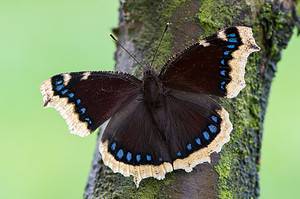There are tons of different yellow and black butterflies out there. While butterflies come in many colors, yellow and black can be quite common.
Colorations can vary in the same butterfly species. Therefore, not all the butterflies listed below are black and yellow all the time.
Here is a list of beautiful yellow and black butterfly species commonly found in North America.

1. Tiger Swallowtail
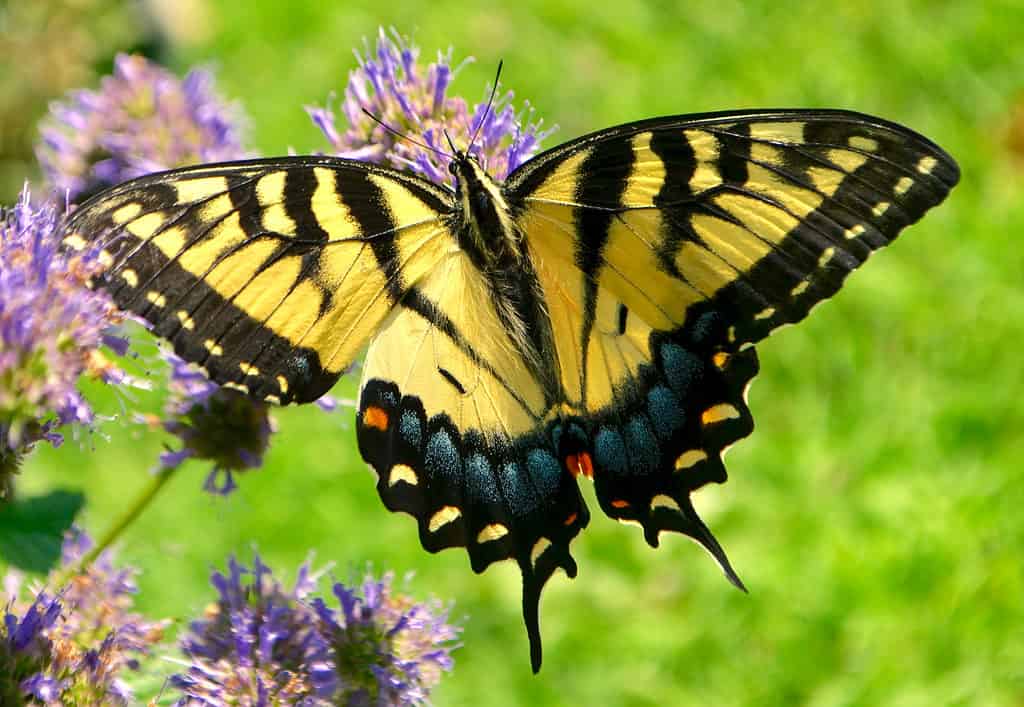
The female
tiger
swallowtail has four black stripes on its forewings with some blue displayed on its hindwing.
©Maria T Hoffman/Shutterstock.com
The tiger swallowtail is found throughout much of North America. You can find it from the eastern parts of the United States to eastern Canada. It’s one of the largest species of swallowtail butterflies, with its wingspan reaching up to 4.5 inches.
The underside of the male’s wings is yellow, but they have four black stripes on each forewing — hence their name. The females have a similar pattern but have some blue on their hindwing and larger tiger stripes.
These butterflies are found in several habitats, including woodlands and suburban gardens. They consume nectar from flowers, rotting fruit, sap, and dung.
When threatened, they release a chemical from their glands to deter predators. However, this chemical is completely harmless to humans.
2. Eastern Black Swallowtail
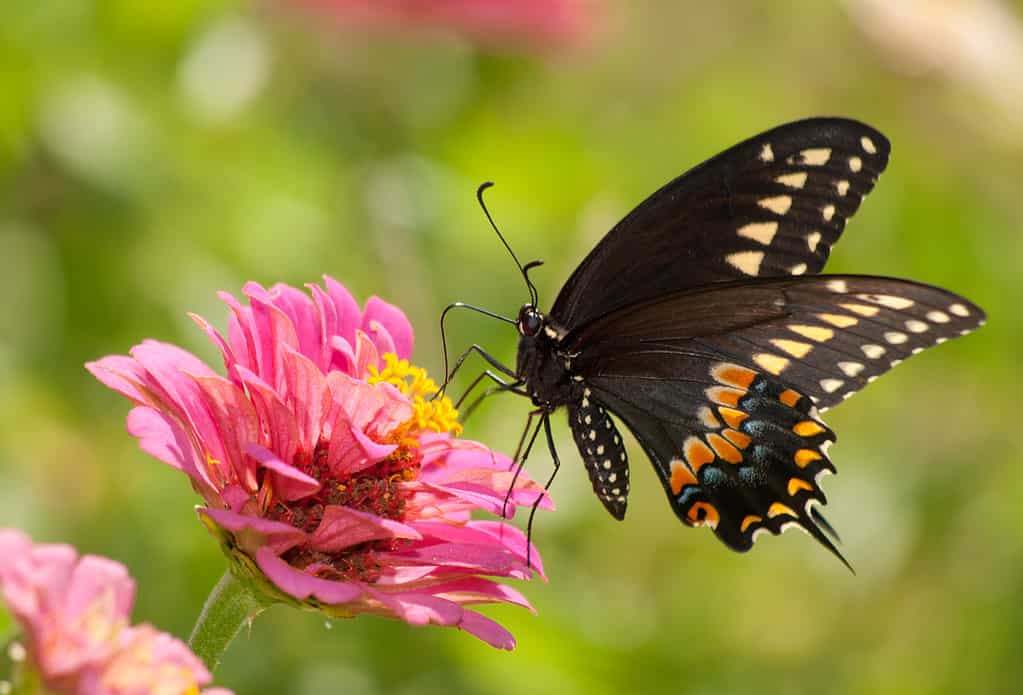
The eastern black swallowtail butterfly is mostly black with yellow markings on the upper side of its wings.
©Sari ONeal/Shutterstock.com
The eastern black swallowtail is native to North America. They’re most commonly found in eastern parts of the United States but also as far north as Canada or as far south as Mexico. This butterfly is one of the world’s largest and most striking butterflies.
Their wingspan can range from 2.7 to 4 inches. The upper side of their wing is mostly black with yellow markings, while the underside is black with white and orange markings. The females have similar patterns, but they have more blue and are often larger.
This butterfly can live in many habitats, including meadows and gardens. They mostly consume nectar from flowers, but the caterpillars consume the leaves of several different plants. They particularly like species of the carrot family, including parsley, dill, and fennel.
The eastern black swallowtail also produces a foul-smelling chemically that deters predators. However, this chemical isn’t dangerous to predators or humans.
3. Clouded Sulphur

The clouded sulfur butterfly is yellow with orange and black markings near its wingtips.
©Steve Byland/Shutterstock.com
The clouded sulphur is an interesting butterfly found throughout much of North America, including Alaska and Mexico. They’re a member of the family Pieridae, which includes many different yellow butterflies.
This butterfly has a wingspan of 1.5 to 2.5 inches. The upper side of their wings is yellow, and they have orange and black markings near their wingtips. The underside is paler, but it has a similar appearance.
You can find them in various environments, including meadows, gardens, and fields. They consume mostly nectar from flowers. The caterpillars feed on the leaves of several different plants, but their favorites are members of the pea family.
This species is migratory. They move northward in the spring and southward in the fall. They overwinter in warmer southern regions.
4. Orange Sulphur

The orange sulphur butterfly has orange upper wings with black markings near its wingtips.
©iStock.com/McKinneMike
The orange sulphur butterfly is also native to much of North America. They’re found in the western United States and southern Canada. They’re another member of the family Pieridae, which we’ve discussed several times in this article. They migrate, moving as the weather changes.
Their wingspan ranges from 1.5 to 2.5 inches. The upper side of their wings is bright orange with black markings near their wingtips. The underside is similar, but it is very pale with yellow markings.
Like other butterflies, they are found in many habitats, including meadows and gardens. They consume mostly nectar, while the caterpillars eat leaves from many plants. Their favorites are clover, alfalfa, and another pea family member.
5. American Lady
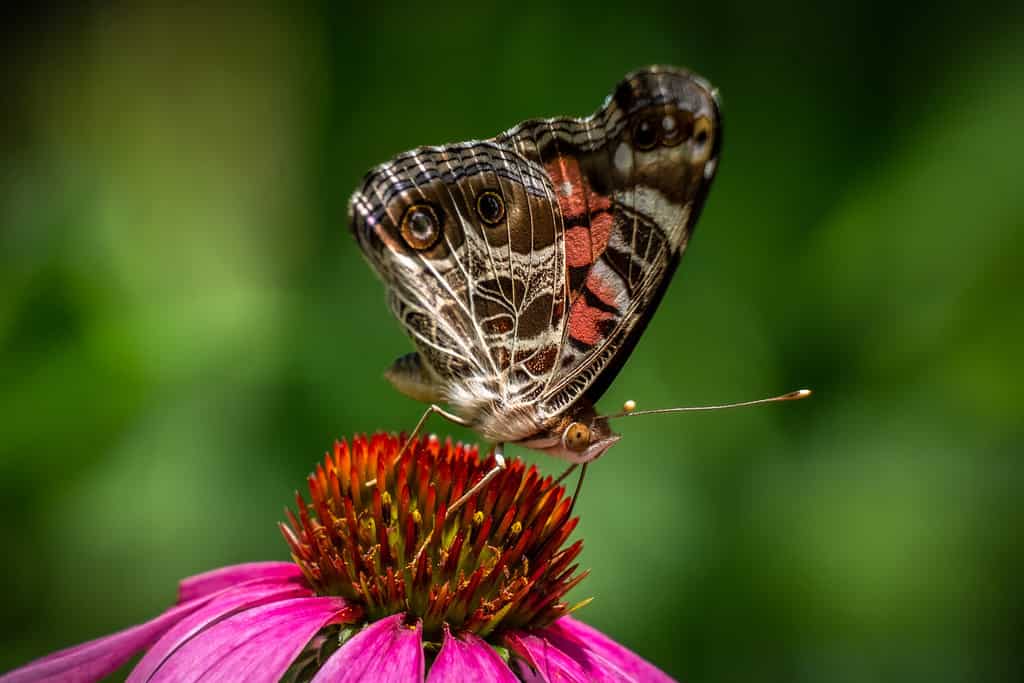
The American lady butterfly is mostly orange and black though can appear yellow in lighter colorations.
©samray/Shutterstock.com
The American lady is more orange than yellow. However, they can appear yellow in lighter colorations. They’re native to North America and found from Canada to Mexico. They’re about as large as the other butterflies, measuring 1.75 to 2.5 inches.
Their wings are mostly orange and black, though they have white spots near the tips of their wings. The underside of their wings are grayish-brown, which helps them camouflage themselves.
The American lady lives in most habitats, including meadows, fields, and gardens. Like most butterflies, they consume nectar as adults. Caterpillars consume the leaves of several different plants, but they prefer aster family members, including sunflowers.
Like many butterflies, the American lady is threatened due to habitat loss and pesticides. There are several conservation efforts to help protect them and other species, though.
6. Painted Lady
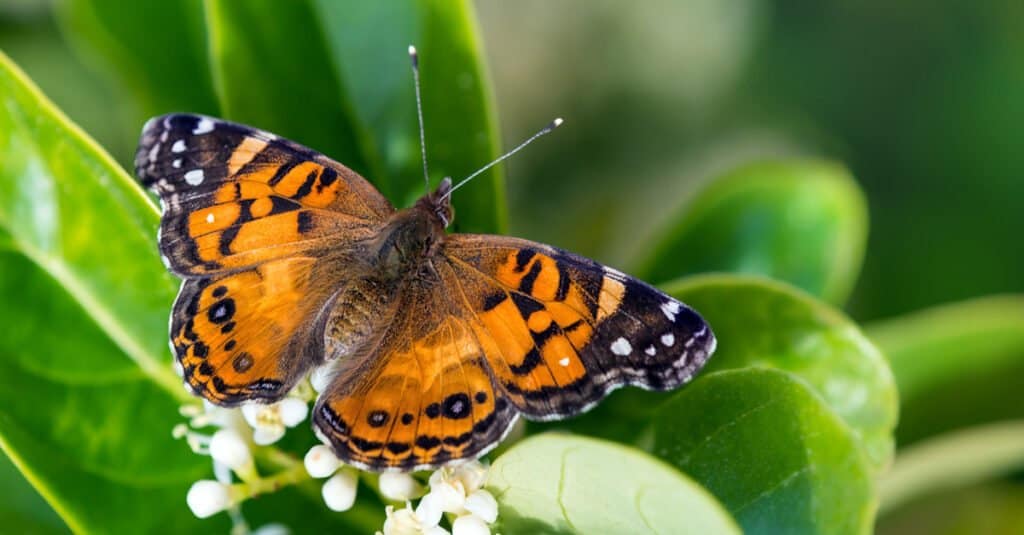
Painted lady butterflies are a highly migratory species, with some butterflies traveling across whole continents.
©iStock.com/leekris
The painted lady is found worldwide, including in North America, Europe, Asia, and Africa. They’re a highly migratory species, with some butterflies traveling across whole continents. This behavior is likely why they are found throughout much of the world.
Their wingspan can reach up to 2.5 inches — about as large as other butterflies on this list. The upper side of their wings is mostly black and orange. The underside of their wings are grayish-brown with eye-like spots, which helps them camouflage themselves.
They’re a generalist species, allowing them to live just about anywhere. They prefer open habitats with plenty of food, like fields, meadows, and gardens. They consume nectar from flowers, but the caterpillars feed on the leaves of just about any plant.
This butterfly is an important pollinator, functioning as a food source for several other birds and animals. Pesticides and a reduction in native flowers threaten them.
7. Variegated Fritillary
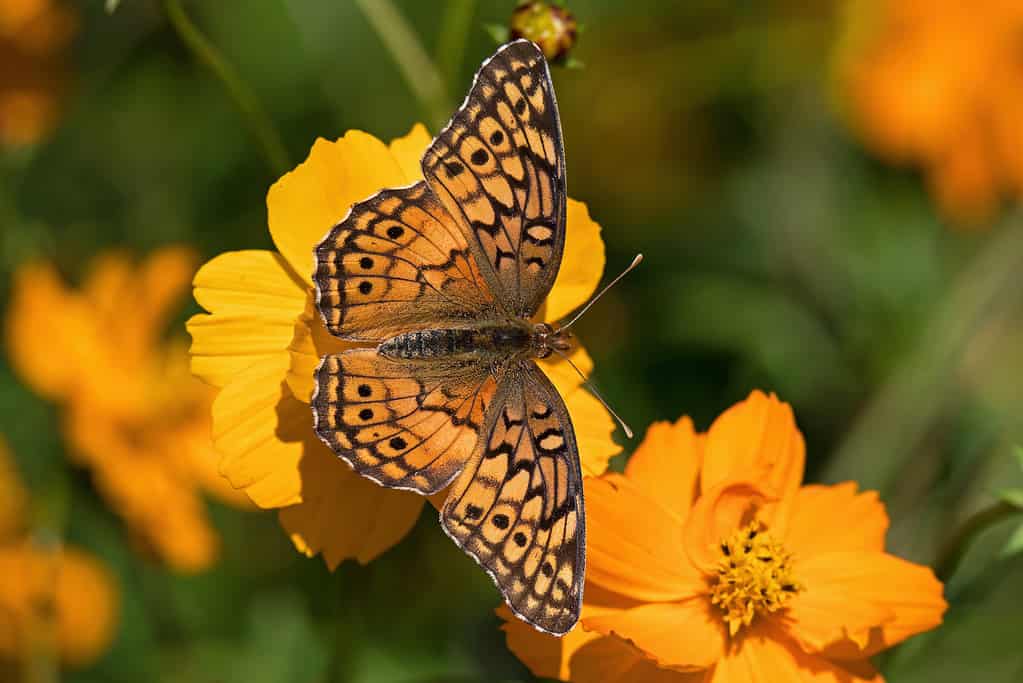
The variegated fritillary butterfly is commonly found in fields, meadows, and woodlands within North and South America.
©iStock.com/McKinneMike
This species of butterfly is related to the previous one. It’s found throughout North and South America. It’s larger than most, with its wingspan reaching up to 3 inches. The upper sides of their wings are orange and black with white spots near their wingtips. The bottom of their wings is brownish-gray.
You can commonly find them in fields, meadows, and woodlands. The adults eat the nectar of many different flowers, but the caterpillars feed on the leaves of several different plants. They prefer members of the violet family, though.
They don’t migrate, but populations may shift slightly as host plants change. The female lays her eggs exclusively on host plants, and the caterpillars feed on these until they become adults.
8. Zebra Longwing
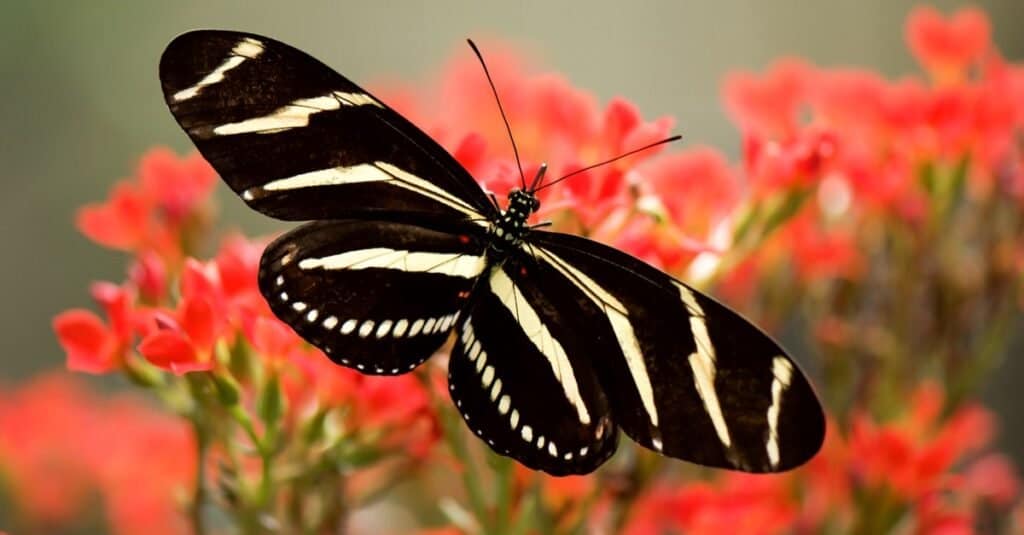
The zebra longwing butterfly lives much longer than most other butterflies, with some living as long as six months.
©Julee75/Shutterstock.com
The zebra longwing is a rather interesting butterfly. It’s native to the southeastern United States and parts of Mexico, Central America, and South America. They’re a brush-footed butterfly.
They have a distinctive appearance with long, narrow wings that are mostly black with white stripes. Their wingspan can range from 2.5 to 3.5 inches. They also have bright yellow markings on their head and thorax, which is how they ended up on this list.
It feeds on both nectar and pollen, unlike most butterflies. Their proboscis is long and narrow, allowing them to consume the nectar deep inside flowers. They need to feed on pollen, which provides essential nutrients.
They live much longer than most other butterflies, with some living as long as six months. Their longer lifespan is due to their unique diet. They can consume and live on the essential nutrients from the pollen they consume.
They are considered important pollinators, and their larvae serve as food for several animals.
9. Common Checkered Skipper
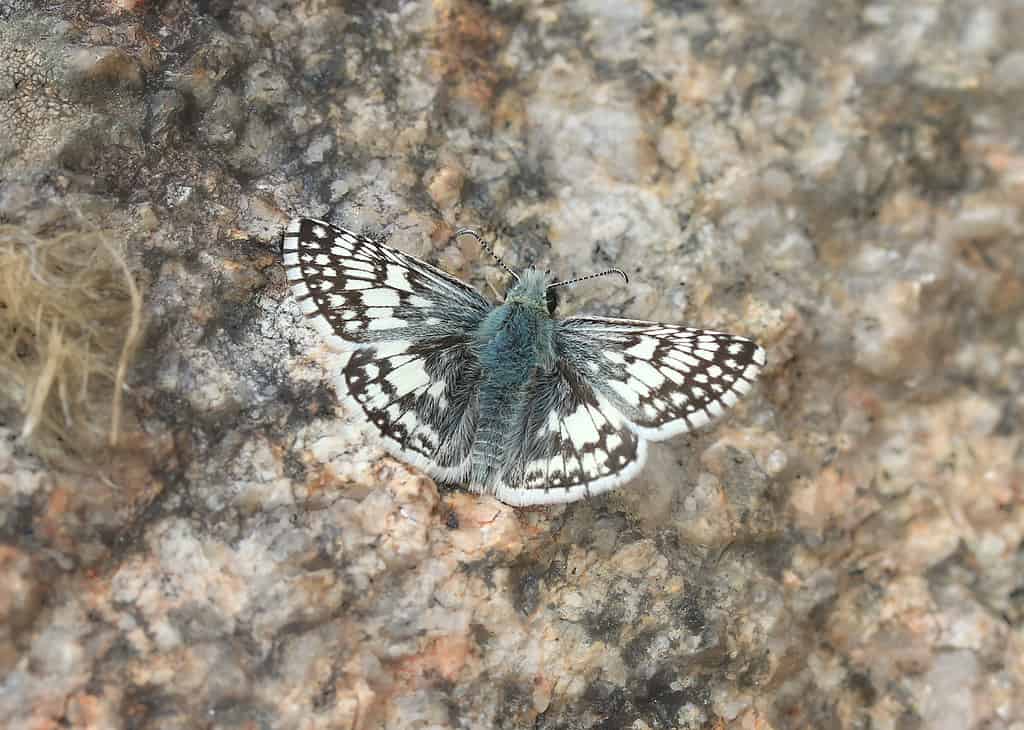
The common checkered skipper butterfly has a distinctive checkerboard pattern.
©vagabond54/Shutterstock.com
The common checkered skipper is small and found throughout much of North America. They belong to the same family as other skippers.
They have a small wingspan of only 1 to 1.5 inches. Their bodies are covered in a distinctive black and white checkered pattern, hence their name. They can sometimes appear yellowish, so we included them on this list.
Like most butterflies, they’re commonly found on prairies, open fields, and meadows. They consume nectar from many flowers, including clovers, asters, and thistles. That said, the larvae mostly eats the leaves of the pea family.
This butterfly makes fast, darting patterns, allowing them to quickly evade predators. Despite their smaller size, they’re extremely strong fliers that can travel long distances.
The common checkered skipper is also sometimes used as a model organism in scientific research. It is relatively easy to rear in the laboratory and has a wide range of ecological and evolutionary questions that can be investigated using this species.
Additionally, the butterfly has unique behavior patterns, such as its fast flight and ability to evade predators, that have been the focus of numerous animal behavior and ecology studies.
10. Cloudless Sulphur
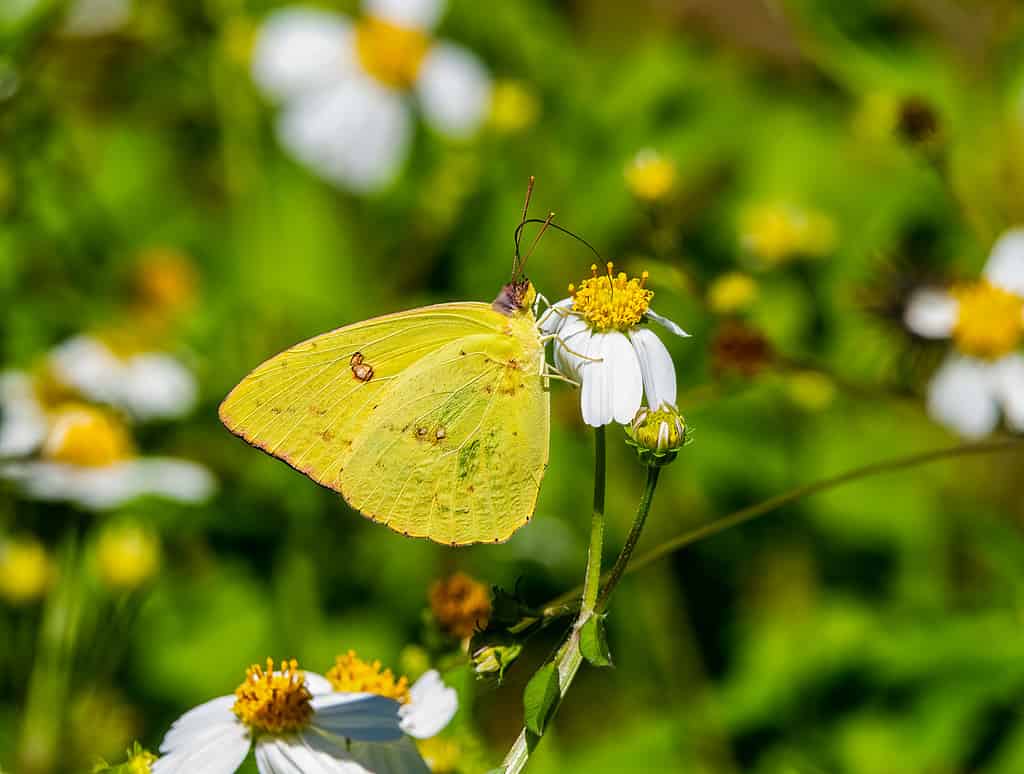
The cloudless sulphur butterfly is bright yellow with black veins and dots throughout its wings.
©iStock.com/Chase D’animulls
The cloudless sulphur is a large species of butterfly found throughout the southern United States and Argentina. Their wingspan ranges from 2.5 to 3.5 inches. The upper surface of their wings is bright yellow, as is the underside. They also have a network of black veins visible on the underside of their wings and a few small black dots.
They prefer the same habitats as other butterflies, including meadows, fields, and gardens. The adults consume the nectar of many different flowers, such as milkweed and Lantana. Their caterpillars feed on the leaves of legume plants.
This butterfly is a strong flier and is known for their migration patterns. They’re known for overwintering in the ground of South Florida in the spring before flying further south in the fall. They may appear in large numbers during periods of migration.
11. Two-Barred Flasher

The two-barred flasher butterfly gets its name from the two bars that run across its wings.
©Danita Delimont/Shutterstock.com
The two-barred flasher is a small to medium sized butterfly belonging to the same family as other skippers. They’re found throughout the southern parts of the United States, including Mexico, Central America, and South America.
They get their name due to the two bars that run across their wings, which stand out against the black background. Their wingspan varies from 1.5 to 2 inches, and they have a rather stocky body.
Like all skippers, they’re known for their fast, erratic fights. They move quickly from flower to flower as they feed on nectar. Their larva consumes leaves of plants in the family Poaceae, which includes sugarcane and Bermuda grass.
They aren’t considered endangered, but their populations are threatened by habitat loss and pesticide use.
These butterflies commonly exhibit a behavior known as “puddling,” where they gather in groups on soil or sand to absorb moisture. This behavior is thought to increase their chances of finding mates, as it enhances attractiveness.
12. Giant Swallowtail
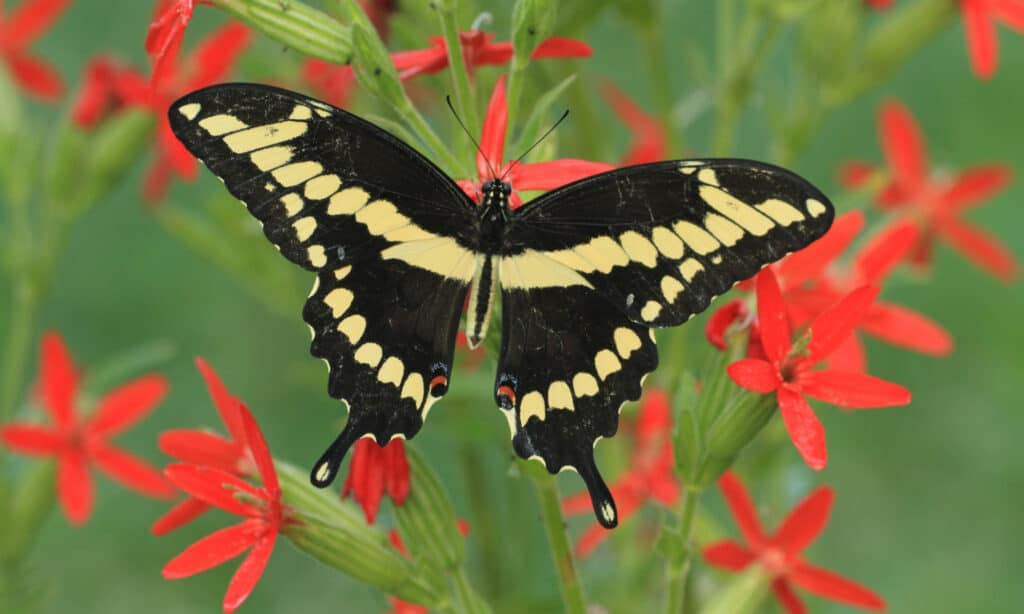
The giant swallowtail is one of the largest butterflies in North America, with a wingspan that can reach up to 6 inches.
©Kevin Collison/Shutterstock.com
As the name suggests, the giant swallowtail is a large butterfly found throughout much of North America. They belong to the swallowtail family, as you might expect from their name.
They’re one of the largest butterflies in North America, with a wingspan that can reach up to 6 inches. The upper surface of their wings is dark brown with yellow markings. The undersides are lighter with orange markings. They have a distinctive tail-like projection at the bottom, which is why they are called swallowtails.
They’re often founded in wooded areas, unlike other butterflies. However, they may also be found in fields and gardens. They feed on various flowers, including thistles, asters, and milkweed. Their caterpillars feed almost exclusively on the leaves of citrus trees.
They’re known for their graceful, slow flight patterns. They can mimic the flight of a bird and are sometimes mistaken for them, which may help them deter predators. Like birds, they can also evade predators by flying in a zigzag pattern.
Giant swallowtails have been particularly studied for their reproductive behavior. They often lay their eggs on the leaves of citrus trees, where caterpillars can feed and grow. The caterpillars also have a unique defense mechanism involving retractable orange horns that they use to scare away predators.
13. Black Swallowtail

The black swallowtail butterfly has a distinctive row of yellow spots on the upper surface of its wings.
©Melody Mellinger/Shutterstock.com
The black swallowtail is a butterfly species found from southern Canada to Mexico. It is related to the previous butterfly, as you might expect.
This butterfly has a wingspan of 2.5 to 4 inches. The upper surface of their wings is black with a distinctive row of yellow spots. They also have a band of blue dots on the edge of their wings. The underside of the wings is lighter but has very similar patterns.
You can commonly find them in fields and meadows, but they may also hang around woodlands and forests. The adult butterflies feed on the nectar of flowers, including thistles, coneflowers, and milkweed. The caterpillars feed almost exclusively on the plant family Apiaceae, which includes parsley, dill, and fennel.
They have very graceful flight patterns, which involve slow, swooping movements. They often move from flower to flower as they feed.
14. Pipevine Swallowtail

The underside of the pipevine swallowtail features white, yellow, and orange markings.
©Danita Delimont/Shutterstock.com
The pipevine swallowtail also has black and yellow colors. However, they’re less yellow than other species. For the most part, they’re black with iridescent blue scaling. Their underside features white, yellow, and orange markings, though. Like all swallowtails, they have distinctive wings that look like tails, with wingspans ranging from 2.75 to 5 inches.
Their range is across the southern half of the U.S., continuing toward the equator to southern Mexico. They’re commonly found in the woodlands, fields, and gardens. They feed on many different plants. However, the caterpillars on consume the leaves of certain plants, like pipevines. These plants contain toxins that make the caterpillars unpalatable to predators.
They’re known for their fast, darting pattern, which allows them to get away from predators verty quickly. They’re also known for their unique courtship behavior, which involves males darting around in large groups and competing to attract females.
These butterflies are not endangered. However, they are harmed by habitat loss and pesticide use. Conservative efforts have begun to prevent their population from decline.
Summary of Beautiful Yellow and Black Butterfly Types
Here’s a recap of the 14 butterflies with yellow and black colorations that we took a look at.
| Number | Butterfly | Range | Wingspan |
|---|---|---|---|
| 1 | Tiger Swallowtail | Throughout much of North America: from the eastern parts of the United States to eastern Canada | Up to 4.5 inches |
| 2 | Eastern Black Swallowtail | Commonly found in eastern parts of the U.S., as far north as Canada and as far south as Mexico | 2.7-4 inches |
| 3 | Clouded Sulphur | Throughout much of North America, including Alaska and Mexico | 1.5-2.5 inches |
| 4 | Orange Sulphur | Western United States and southern Canada | 1.5-2.5 inches |
| 5 | American Lady | From Canada to Mexico | 1.75-2.5 inches |
| 6 | Painted Lady | Worldwide, including in North America, Europe, Asia, and Africa | Up to 2.5 inches |
| 7 | Variegated Fritillary | Throughout North and South America | Up to 3 inches |
| 8 | Zebra Longwing | Native to the southeastern U.S. and parts of Mexico, Central America, and South America | 2.5-3.5 inches |
| 9 | Common Checkered Skipper | Throughout much of North America | 1-1.5 inches |
| 10 | Cloudless Sulphur | Throughout the southern United States and Argentina | 2.5-3.5 inches |
| 11 | Two-Barred Flasher | Throughout the southern parts of the United States, including Mexico, Central America, and South America | 1.5-2 inches |
| 12 | Giant Swallowtail | Throughout much of North America | Up to 6 inches |
| 13 | Black Swallowtail | From southern Canada to Mexico | 2.5-4 inches |
| 14 | Pipevine Swallowtail | Across the southern half of the U.S., continuing toward the equator to southern Mexico | 2.75-5 inches |
The photo featured at the top of this post is © Ron Rowan Photography/Shutterstock.com
Thank you for reading! Have some feedback for us? Contact the AZ Animals editorial team.





